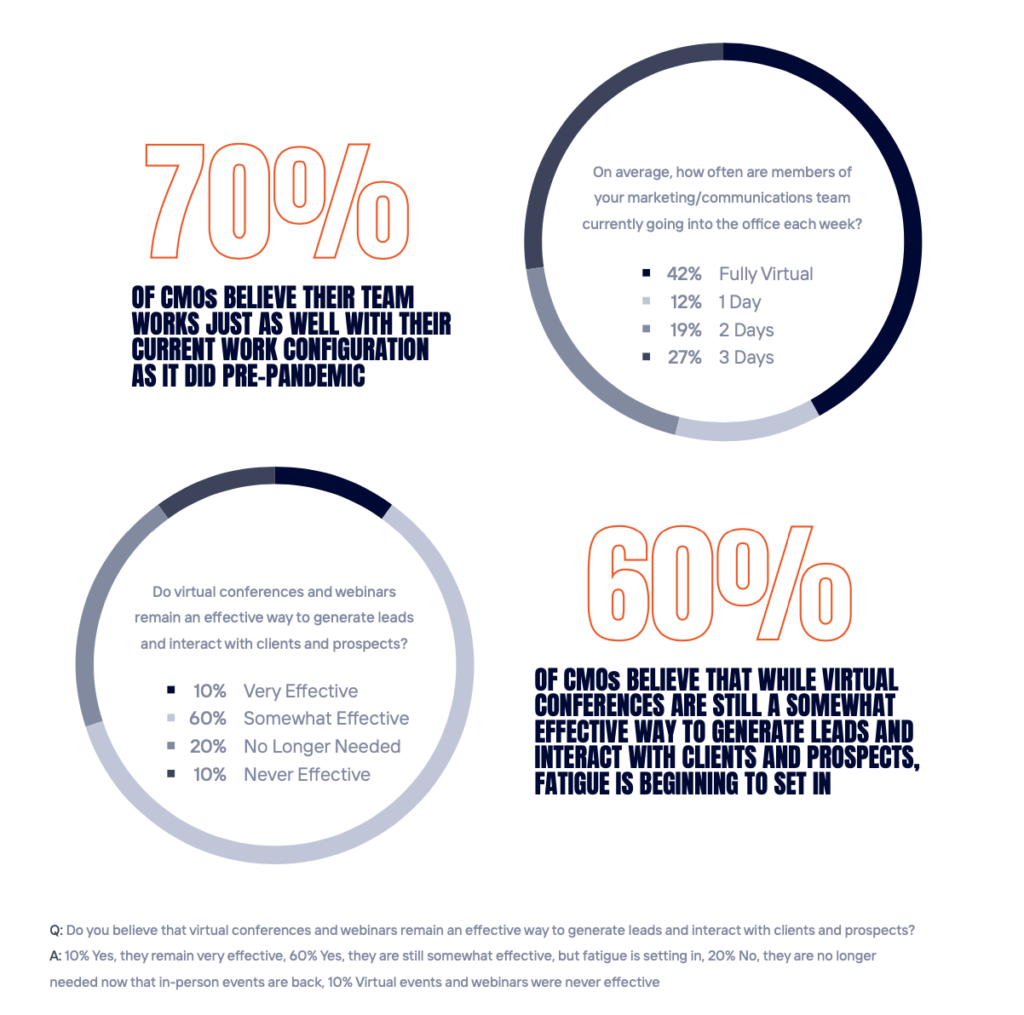Below is an excerpt from our 2022 Fintech CMO Survey Report, a deep dive into the opinions and mindsets of a wide range of senior fintech marketers. Over the next few weeks, as firms across the industry set their marketing budgets for 2023, we are highlighting some of the report’s key findings. Download the full report here.

When it comes to remote or hybrid means of working and interacting within the fintech marketing industry, not all settings are created equal
Preparing for the “future of work” has been a longstanding priority across myriad industries, but the onset of the COVID-19 pandemic forced our collective understanding of this concept to evolve. While growing pains continue for some, the pandemic has accelerated several work trends that likely would have taken years to implement otherwise. Among these, the most far-reaching has been the move to virtual and hybrid work models, as knowledge workers have been forced to make the unexpected shift to working from home.
The ever-shifting circumstances of the pandemic continue to alter the way organizations think about work, but there seems to be no question that remote work – whether fully or partially – is here to stay. Our survey found that over 40% of fintech CMOs and their marcomms teams have gone fully virtual, with the remaining respondents having transitioned to hybrid models requiring a varying number of days in the office. In December 2021 and January 2022 when the survey was conducted, none of our respondents said they were currently going into the office more than three days a week, nor were they doing so prior to the Omicron variant’s arrival.
Is Work From Home Better for Fintech Marketing?
With unprecedented flexibility in terms of both their schedules and their physical location, employees are now able to focus more on tasks that matter and become more productive. Our survey revealed that of the CMOs and senior marketing professionals managing hybrid and fully remote workers, nearly 70% believe their team works just as well with their current work configuration as it did pre-pandemic.
Of course, working from behind screens creates a different kind of team dynamic, making communication more important than ever before. As noted by Adebiyi (Itiviti), there is an undeniable advantage to conveying critical ideas and concepts to colleagues in person.
“Virtual work is here to stay, but meeting with people face to face is still going to be important. Some things are just better conveyed when you can meet with people directly and remove any roadblocks to communication,” said Adebiyi. “As powerful as our virtual tools are and convenient as working from home may be, it takes away the human element. You may be able to work effectively, but there are limitations.”
Updates that lead to new insights around business approaches and candid conversations with industry peers are, in my opinion, the most valuable aspects of time spent at a conference. And those experiences are just too hard to recreate digitally.”
Melinda Joseph, CMO, Sterling Trading Tech
Zoom Fatigue
Despite an environment where we are more connected than ever, it appears that this lack of the human element is also behind the dwindling appetite for virtual conferences. Our survey revealed that 60% of CMOs believe that while virtual conferences and webinars are still a somewhat effective way to generate leads and interact with clients and prospects, fatigue is beginning to set in. Per our respondents, “Zoom fatigue” is partially to blame, but so are the inherent limitations of making connections digitally compared to the power of in-person conversations.
“Some of the big industry conferences are key to understanding what is next in the space as well as the pain points of current and potential clients,” said Joseph (Sterling Trading Tech). “Updates that lead to new insights around business approaches and candid conversations with industry peers are, in my opinion, the most valuable aspects of time spent at a conference. And those experiences are just too hard to recreate digitally.”
Looking to the future of the events landscape, fintech marketing professionals must rise to a new challenge: facilitating digital experiences that not only engage, but enable the same results of the in-person interaction that so many missed. While there may not be a definitive answer as to what this looks like just yet, Lengua suggests the answer might lie in striking the right balance.
“As the world opens back up a bit, and with everything we’ve all learned about hybrid work, what I hope to see is more events that are specifically designed for a hybrid format. I want to see more livestreams of events that also have an in-person component,” said Lengua (Enimrac). “This is obviously going to create some complexity, but it just expands your audience and reach so much. On-demand webinars serve a purpose, but a live event will almost always be more engaging.”
Read on for the next post highlighting key findings of our 2022 Fintech CMO Survey Report.